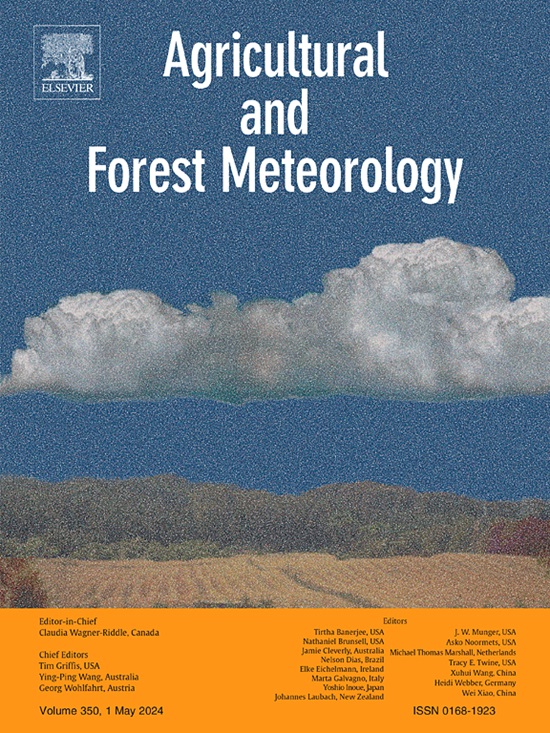Combining automated and manual chambers to provide reliable estimates of N2O emissions in annual and perennial cropping systems
IF 5.6
1区 农林科学
Q1 AGRONOMY
引用次数: 0
Abstract
Perennials can produce more biomass and partially replace annual crops. However, environmental benefits of perennials over annuals in terms of nitrous oxide (N2O) emissions have rarely been compared in a long-term field experiment. By combining automatic and manual chamber methods, we aimed to develop reliable N2O estimates from annual and perennial systems. We measured N2O emissions from: i. perennial grass during renovation including spring barley as catch crop (SB/RG); ii. perennial grass-clover mixture (GC); iii. triticale monoculture (Trit). Results showed that cumulative N2O emissions from SB/RG were higher than GC or Trit. The highest emission rate was measured for SB/RG (258.9 µg N2O![]() N m-2 h-1) after fertilization in spring. Increased N2O emissions were also seen for a short period after direct grass seeding in August. For Trit, N2O emissions increased after fertilization in March and ploughing in late September. In GC (fertilized with P and K), there was no N2O peak after grass cutting. Both from manual and automatic chamber systems, “hot moments” of N2O emissions contributed ∼16–79 % of cumulative emissions. By predicting hot moments and scheduling frequent measurements, manual chambers captured most of the N2O dynamics. The results indicated that the hot moments of N2O emissions were better quantified by automatic chambers, while some of the hot moments, for instance, fertilization and ploughing in Trit were accurately captured with manual chambers. Soil nitrate and ammonium were positively associated with N2O emissions, whereas biomass N uptake was negatively associated. We conclude that perennial (GC) is a promising system for high biomass production with low environmental impact. Strategies such as growing spring barley as a catch crop, grass seeding with shallow tillage, and fertilization of newly seeded grass matching crop N demand are needed to reduce the higher risk for N losses.
N m-2 h-1) after fertilization in spring. Increased N2O emissions were also seen for a short period after direct grass seeding in August. For Trit, N2O emissions increased after fertilization in March and ploughing in late September. In GC (fertilized with P and K), there was no N2O peak after grass cutting. Both from manual and automatic chamber systems, “hot moments” of N2O emissions contributed ∼16–79 % of cumulative emissions. By predicting hot moments and scheduling frequent measurements, manual chambers captured most of the N2O dynamics. The results indicated that the hot moments of N2O emissions were better quantified by automatic chambers, while some of the hot moments, for instance, fertilization and ploughing in Trit were accurately captured with manual chambers. Soil nitrate and ammonium were positively associated with N2O emissions, whereas biomass N uptake was negatively associated. We conclude that perennial (GC) is a promising system for high biomass production with low environmental impact. Strategies such as growing spring barley as a catch crop, grass seeding with shallow tillage, and fertilization of newly seeded grass matching crop N demand are needed to reduce the higher risk for N losses.
结合自动化和手动室,提供一年生和多年生种植系统中N2O排放的可靠估计
多年生植物可以产生更多的生物量,并部分取代一年生作物。然而,就氧化亚氮(N2O)排放而言,多年生植物比一年生植物的环境效益很少在长期的田间试验中进行比较。通过结合自动和手动室方法,我们旨在从一年生和多年生系统中建立可靠的N2O估算。我们测量了N2O排放:i.改造期间多年生草,包括作为捕获作物的春大麦(SB/RG);2。多年生草-三叶草混合物;3。单一栽培小黑麦(Trit)。结果表明,SB/RG的累积N2O排放量高于GC和Trit。SB/RG在春季施肥后的排放率最高,为258.9µg N2ON m-2 h-1。在8月份直接播种后的短时间内,N2O排放量也有所增加。在3月施肥和9月下旬耕作后,Trit的N2O排放量增加。在GC (P和K施肥)中,割草后没有N2O峰值。无论是手动还是自动腔室系统,N2O排放的“热时刻”贡献了累积排放量的约16 - 79%。通过预测热时刻和安排频繁的测量,手动室捕获了大部分N2O动态。结果表明,自动室能较好地量化N2O排放的热时刻,而手动室能较准确地捕获Trit施肥和耕作等部分热时刻。土壤硝态氮和铵态氮与N2O排放量呈正相关,而生物量氮吸收量与N2O排放量呈负相关。因此,多年生植物是一种极具潜力的高生物量、低环境影响的生态系统。为了降低较高的氮素损失风险,需要采取诸如将春大麦作为捕获作物种植、浅耕播种草以及根据作物氮素需求对新种草进行施肥等策略。
本文章由计算机程序翻译,如有差异,请以英文原文为准。
求助全文
约1分钟内获得全文
求助全文
来源期刊
CiteScore
10.30
自引率
9.70%
发文量
415
审稿时长
69 days
期刊介绍:
Agricultural and Forest Meteorology is an international journal for the publication of original articles and reviews on the inter-relationship between meteorology, agriculture, forestry, and natural ecosystems. Emphasis is on basic and applied scientific research relevant to practical problems in the field of plant and soil sciences, ecology and biogeochemistry as affected by weather as well as climate variability and change. Theoretical models should be tested against experimental data. Articles must appeal to an international audience. Special issues devoted to single topics are also published.
Typical topics include canopy micrometeorology (e.g. canopy radiation transfer, turbulence near the ground, evapotranspiration, energy balance, fluxes of trace gases), micrometeorological instrumentation (e.g., sensors for trace gases, flux measurement instruments, radiation measurement techniques), aerobiology (e.g. the dispersion of pollen, spores, insects and pesticides), biometeorology (e.g. the effect of weather and climate on plant distribution, crop yield, water-use efficiency, and plant phenology), forest-fire/weather interactions, and feedbacks from vegetation to weather and the climate system.

 求助内容:
求助内容: 应助结果提醒方式:
应助结果提醒方式:


